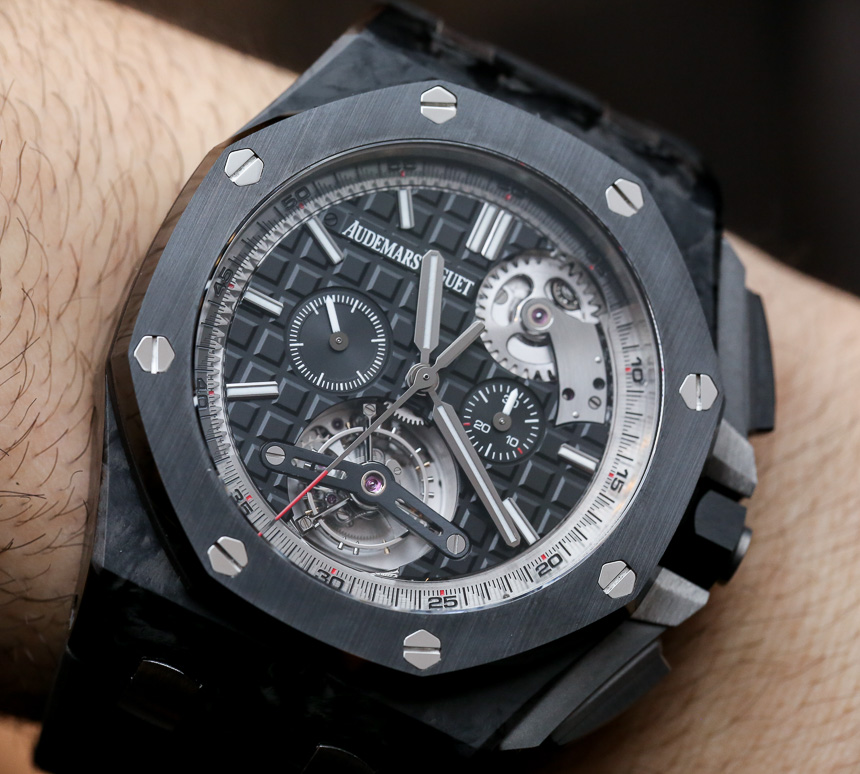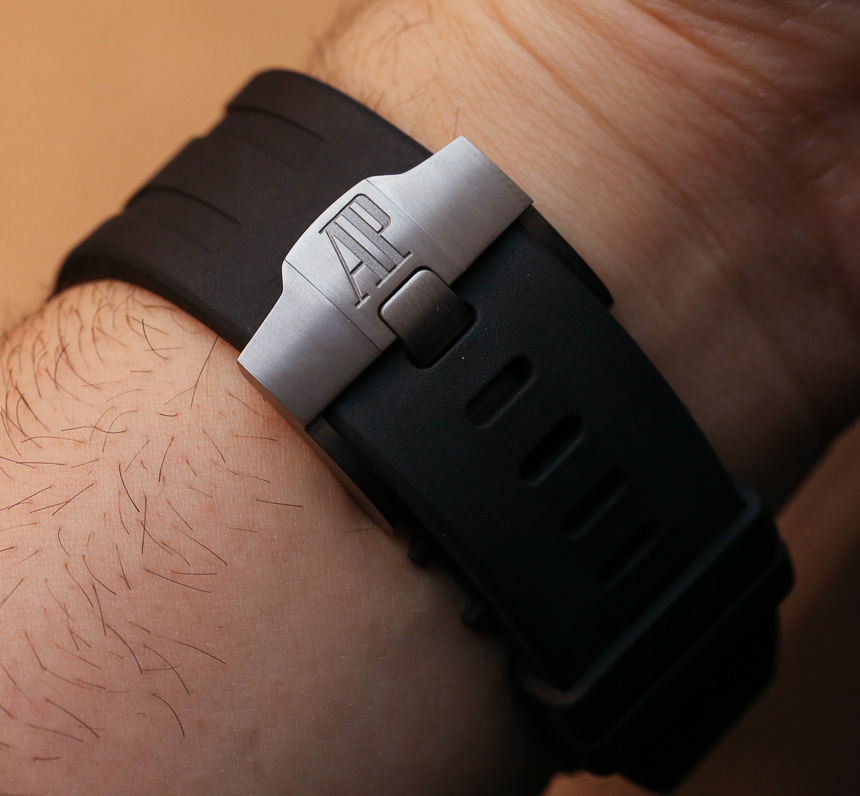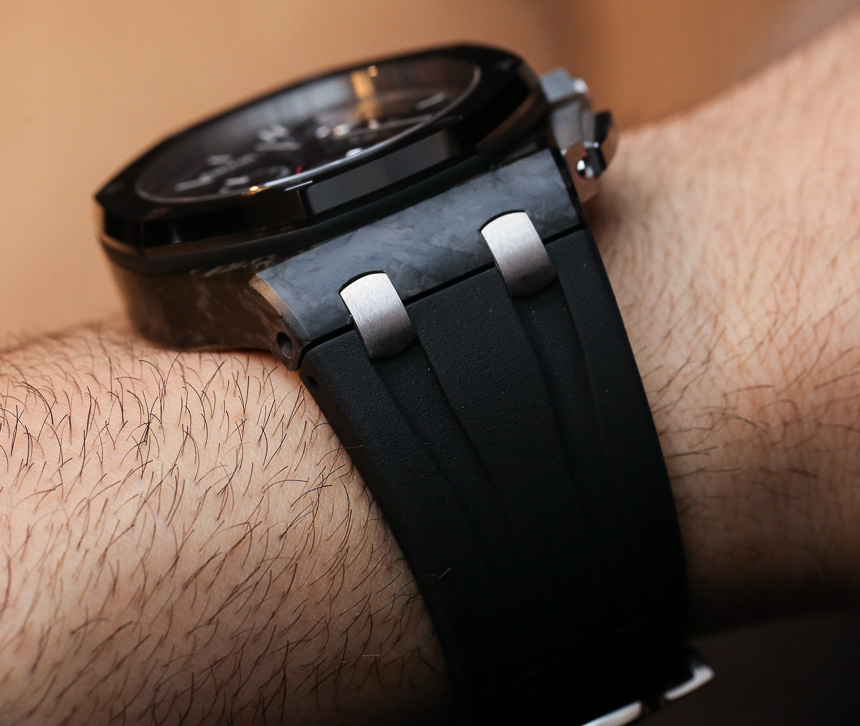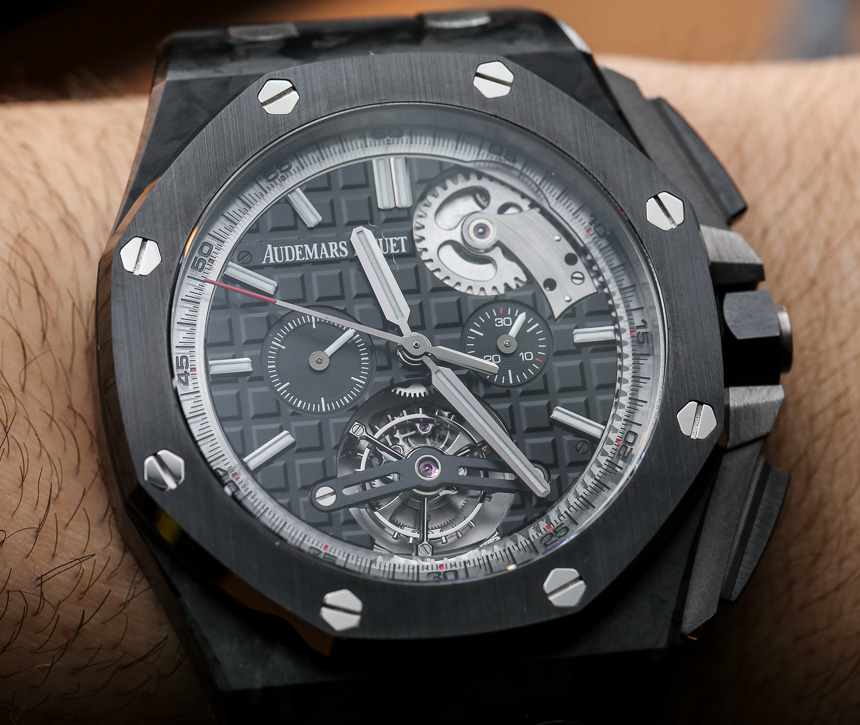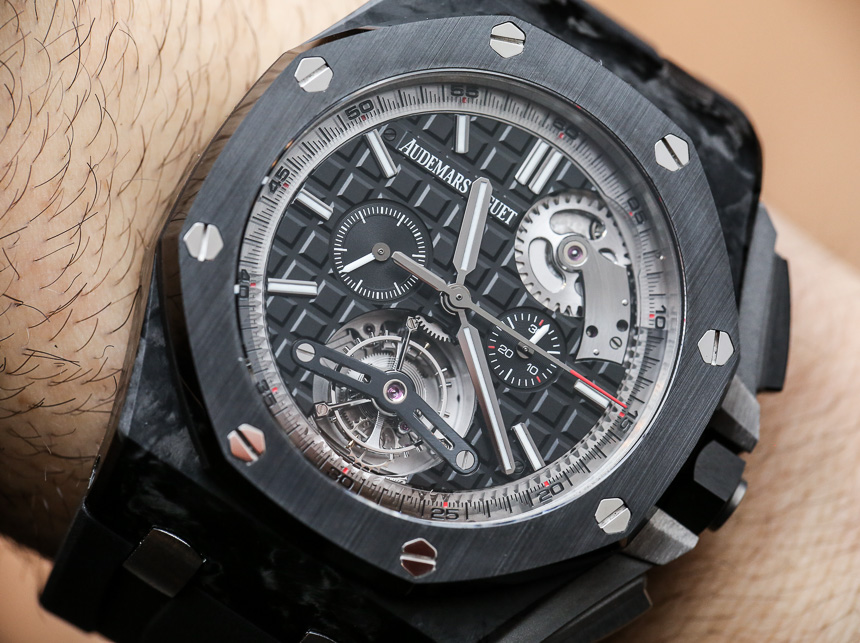
Since its debut in 1992, the Audemars Piguet Royal Oak Offshore has housed all sorts of complications in its virile, sporty case. The pinnacle of these endeavors surely was the $740,000 Grand Complication (hands-on here), but today we are looking at a more typical-for-AP combination of fine complications: the tourbillon chronograph. Let’s see what this bold, complex-looking thing, the Audemars Piguet Royal Oak Offshore Selfwinding Tourbillon Chronograph (debuted here), has to offer.
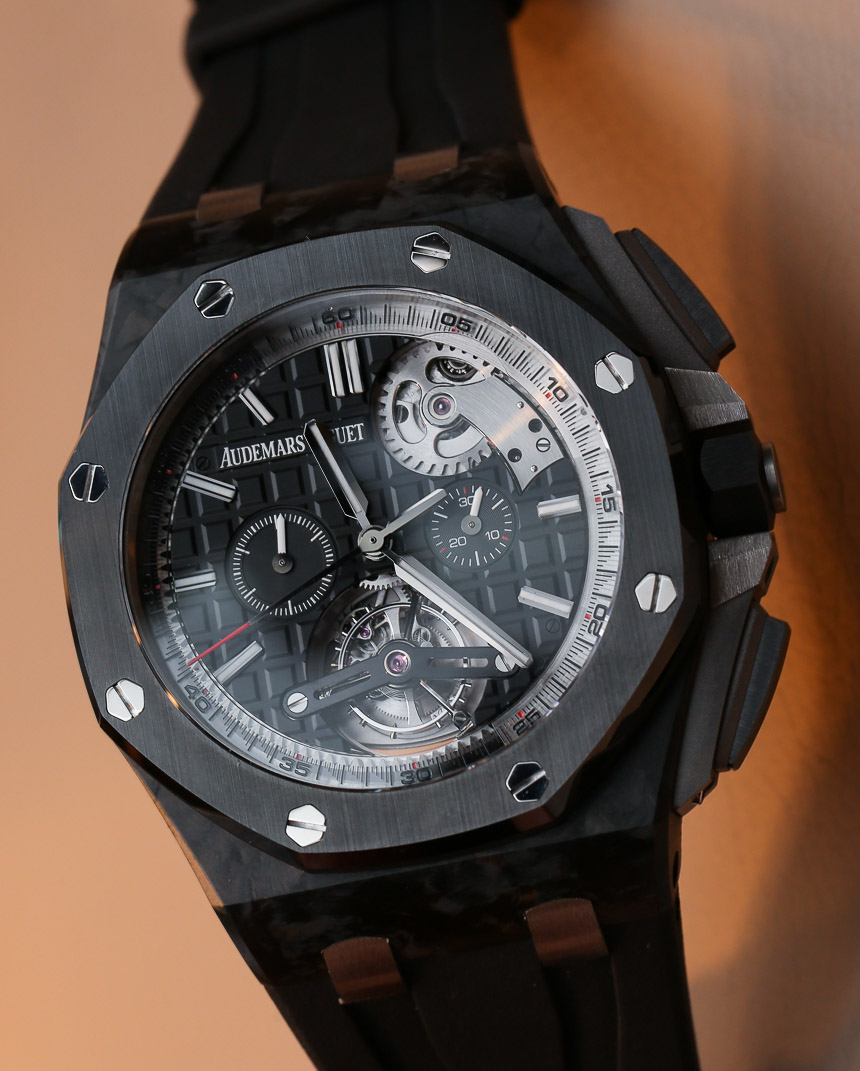
When the first Royal Oak Offshore made it to the market in 1993 with its beefy 42mm case, many observers thought that Audemars Piguet may have missed the mark with its spinoff on the iconic Royal Oak. Some said it was too big for a conventional sports watch… but let’s not forget that when Gérald Genta introduced the Royal Oak in 1972, the world’s first “luxury sports watch” in a stainless steel case and a price tag well above that of a gold watch, the reaction was similarly conservative. It took time for the market to digest the radical proposal, but once it was accepted, a real success story began to unfold.
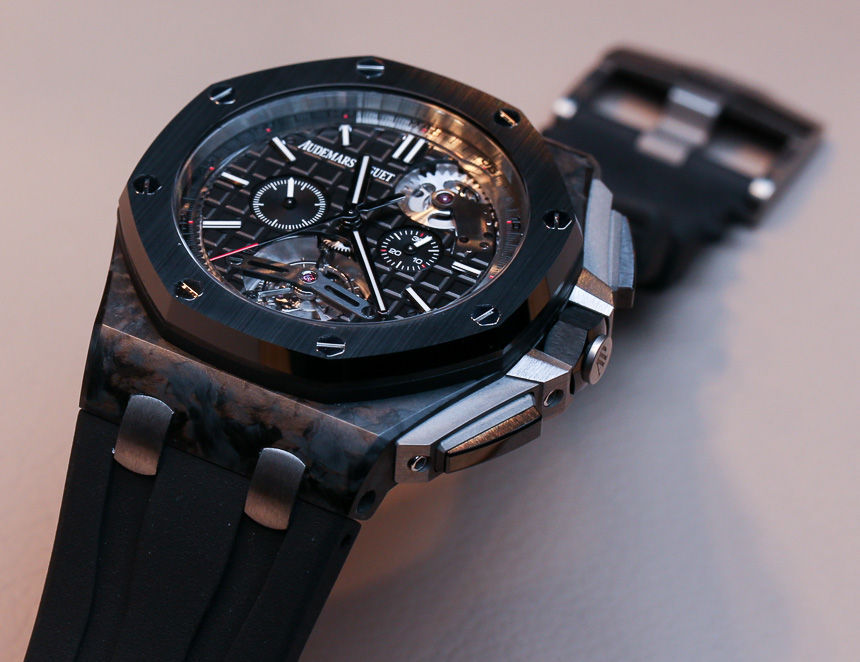
With its industrial architecture and the incorporation of the oversized chronograph pushers protected with rubber guards, the “ROO” consolidated its imposing character. The dramatic high-tech character and performance of the watch made it (at least appear to be) suitable for extreme sports, all the while maintaining some of that original, powerful, elegant Royal Oak vibe.
We have come a long way since the original Royal Oak Offshore, though, so enough with looking to the past, and let’s see what this high-complication version brings to the table.
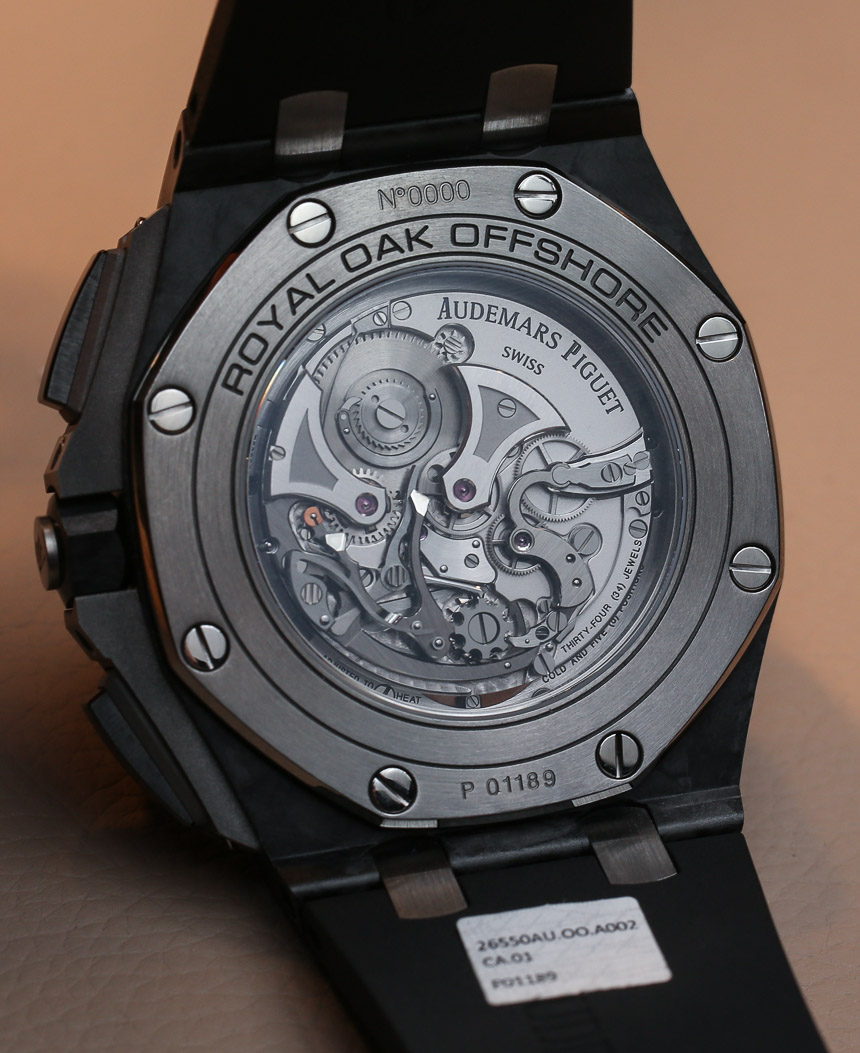
Audemars Piguet tends not to shy away from developing and introducing new and ever more complicated high-end movements – while they nevertheless seem to take their time when it comes to upgrading their more ubiquitous movements, as testified to by the new ROO Diver Chronograph (hands-on coverage and explanation here).
Anyhow, with the Caliber 2897 inside the Audemars Piguet Royal Oak Offshore Selfwinding Tourbillon Chronograph, they went on to add a bit to the tried and proven recipe of a tourbillon chronograph by equipping it with a peripheral automatic winding rotor. Clearly, one of the aesthetic issues with automatic movements is that the central rotor hides almost half of the movement’s components – and if there ever were a “first world problem” in watch design, then this must be it. Worry not, though, as Audemars Piguet has engineered the 2897 to have a peripheral winding rotor crafted from platinum.
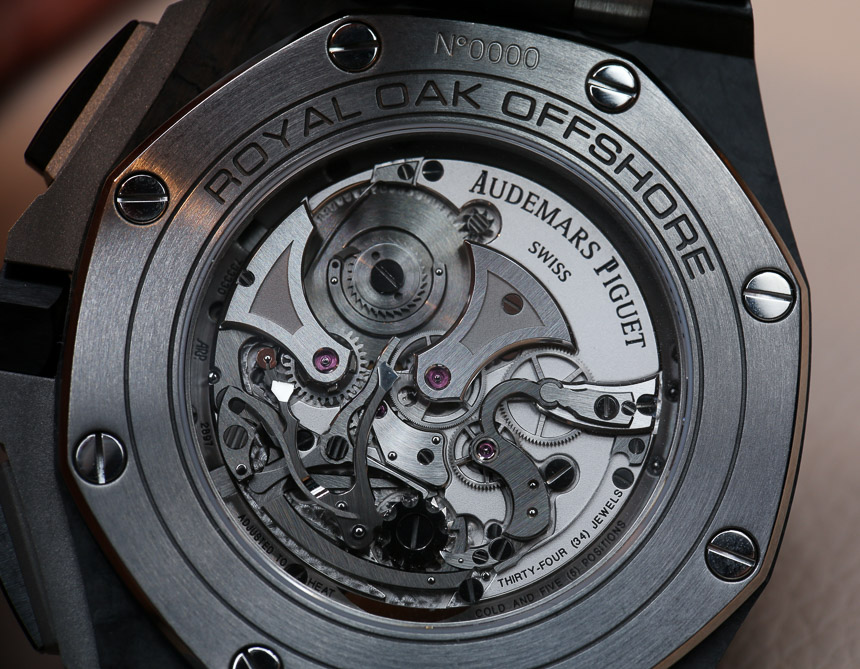
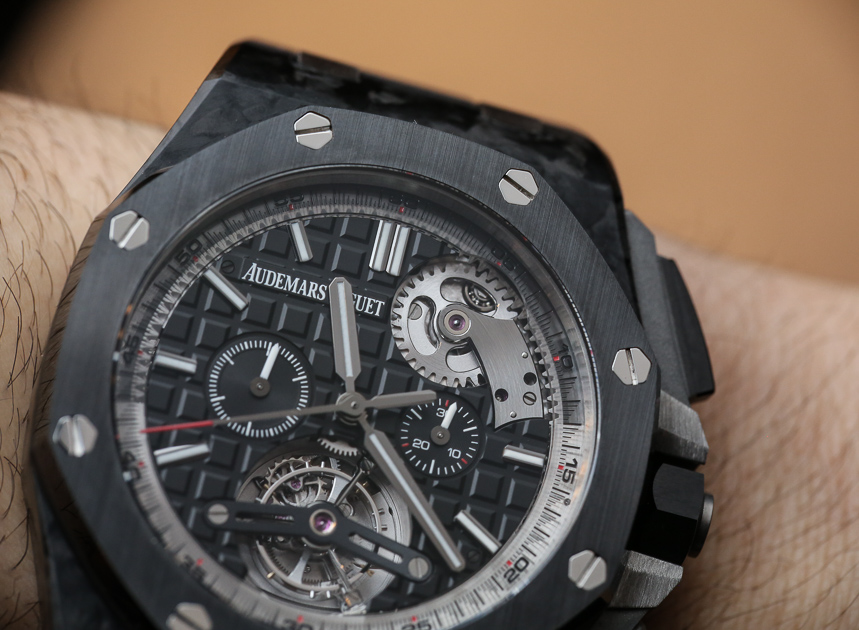
To offer the wearer an uninhibited view of the movement, the watch is equipped with a peripheral rotor that swirls around the movement as opposed to sitting on top of the movement. This is not the first time we have seen a peripheral rotor (Jaeger-LeCoultre, for example, used one in their Master Ultra-Thin Minute Repeater Flying Tourbillon) but, if one of the main draws of high-end watchmaking is the privilege of admiring the movement, one wonders why they aren’t used more often. In the case of the Audemars Piguet Royal Oak Offshore Selfwinding Tourbillon Chronograph, the platinum oscillating weight charges 180 degrees in both directions and glides on ball bearings. The choice of platinum for the rotor is designed to add weight, maximizing inertia to charge the mainspring.
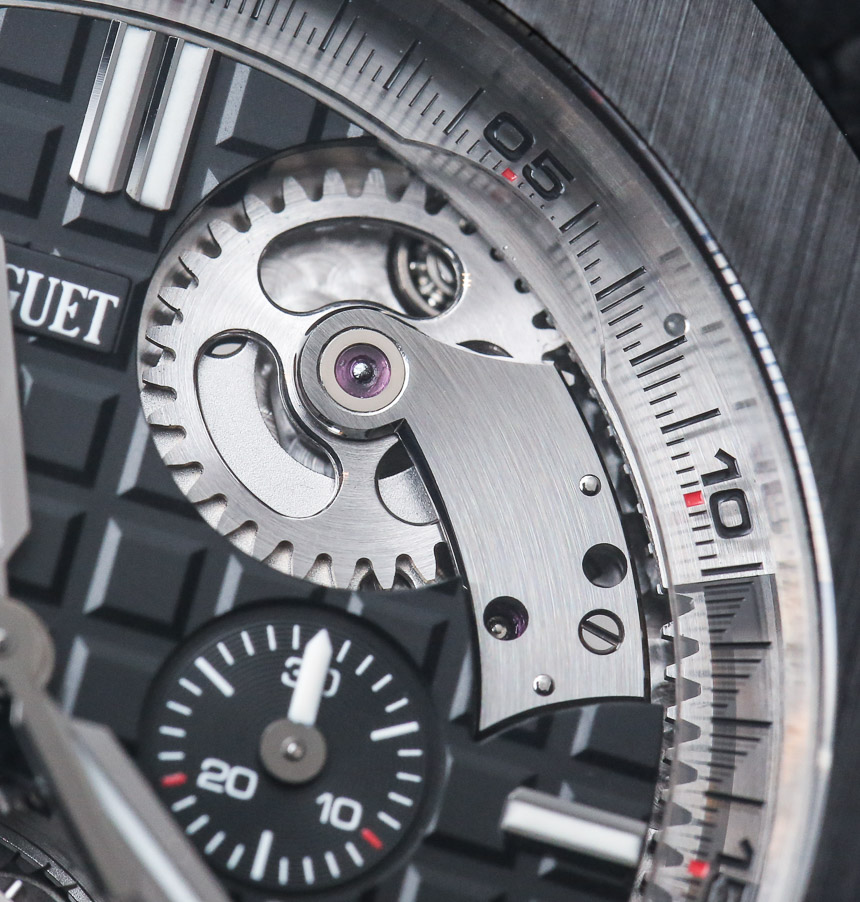
The semicircular platinum rotor swings around the top part of the calibre giving the watch one of its coolest features… but more on that in a bit. According to Audemars Piguet, more than 30% of the cost of this watch is generated by the decoration of the movement. Revealed in all its splendor, the movement is beautifully executed with hand-bevelled edges, satin polished flat surfaces and bevelled and polished edges on the levers and bridges. Particularly eye-catching are the two large bridges with sandblasted centers.
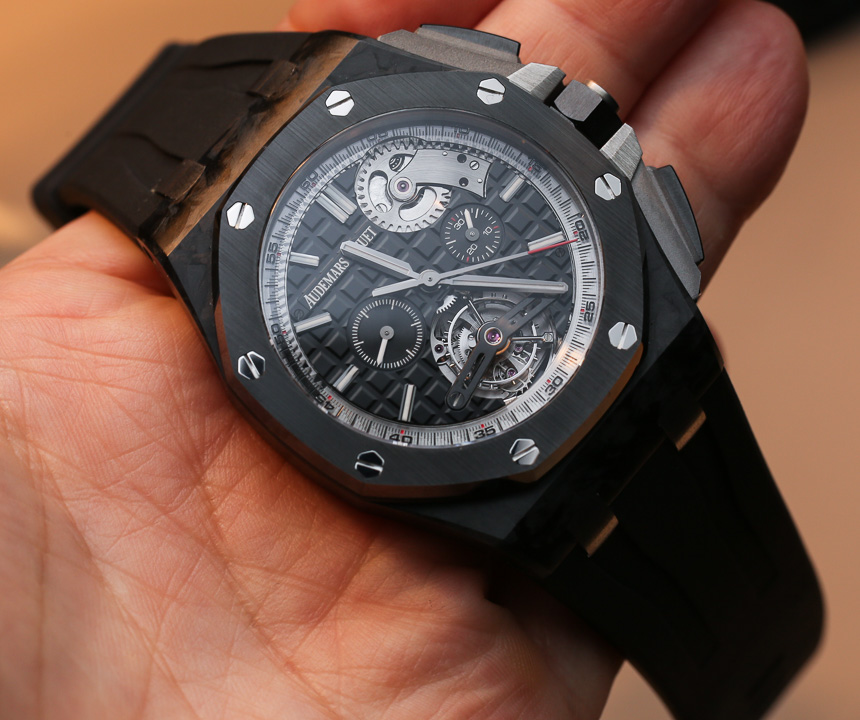
The 35mm caliber is housed in a high-tech forged carbon case measuring 44mm. The height of the watch is 14mm, conforming to the construction specs of the ROO which is meant to be big all-around regardless of the complications housed within. Brushed black ceramic is used on the bezel, and the pushers, crown, as well as pushpiece guards are made from titanium, endowing the watch with a formidable personality.
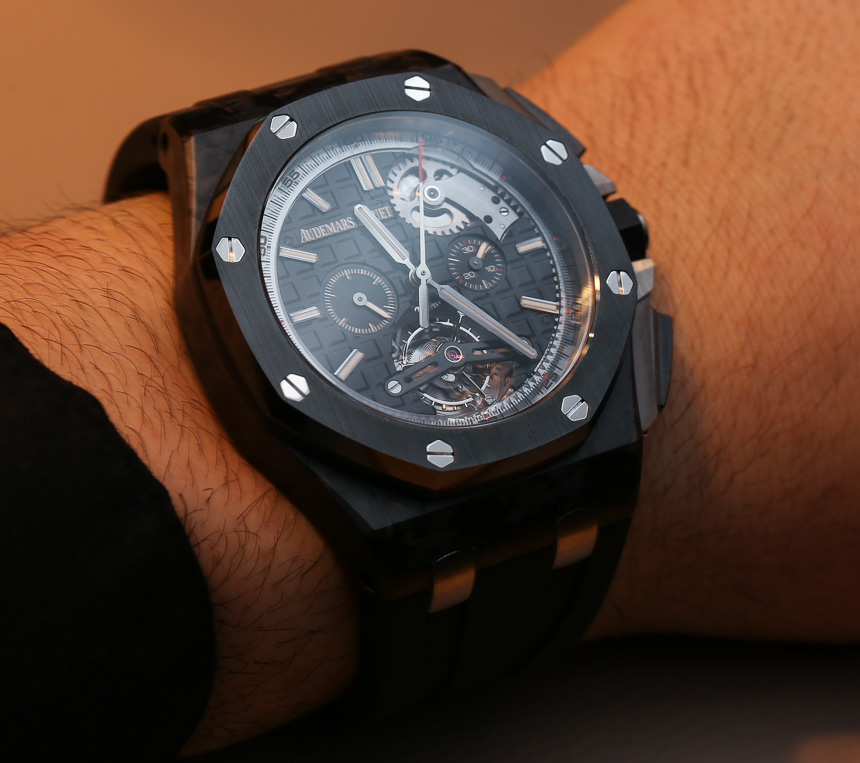
The layout of the dial is, in my opinion, the most debatable aspect of the Audemars Piguet Royal Oak Offshore Selfwinding Tourbillon Chronograph. With its signature checkerboard pattern, the part that everybody loves is the exterior border of the dial with a transparent sapphire crystal ring allowing you to watch the rotor swing back and forth. The Scalextric effect is really cool and will have you gazing at the dial for hours. And, as the rotor performs its rotations under the dial, a large gear positioned at 1 o’clock on the dial moves in time to the rotor.
I’m afraid this is the gear of our discontent. The aperture at 1 o’clock houses the gear as well as the bridge that keeps it in place. The space required to accommodate the elements means that the 30-minute subdial of the chronograph has been reduced in size while the running seconds subdial on the left maintains the same proportions as the 2011 model.
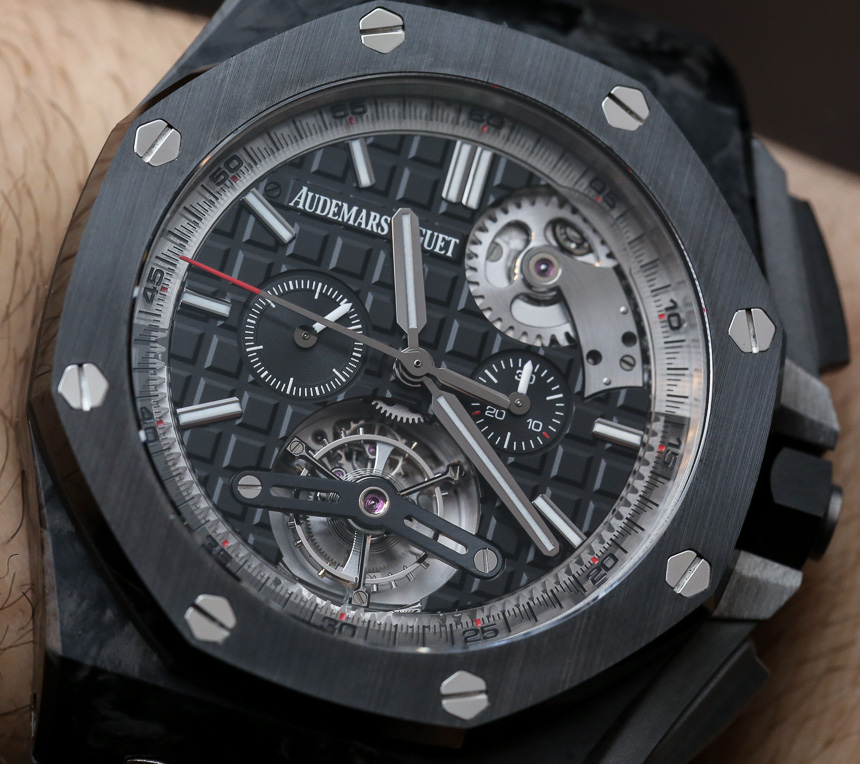
The tourbillon – another of the 25 tourbillons developed by the manufacture – is located in an aperture at 6 o’clock. As a 60-second tourbillon with a balance wheel oscillating at 21,600 alt/H (3,00Hz), the ensemble puts on a great show, although the view is somewhat obstructed by the blackened titanium bridge. All the different-sized apertures on the dial create an unbalanced effect and might not be to everybody’s liking.
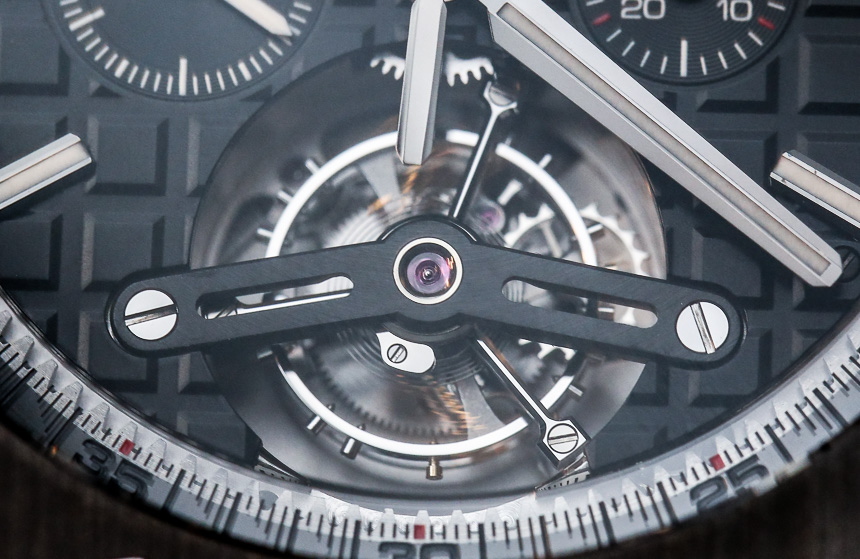
Personally, I would have liked the bridge of the gear train at 1 o’clock hidden under the dial. The tapisserie-pattern checker board motif of the Royal Oak family is so ubiquitous that we take it for granted, but it has become one of the most salient dial decorations in watchmaking history, and viewed up close, you can appreciate the delicate guilloché work. It creates a subtle and beautiful game of light across the surface of the dial. That’s why, for me, the more of this tapisserie there is on the dial, the better.
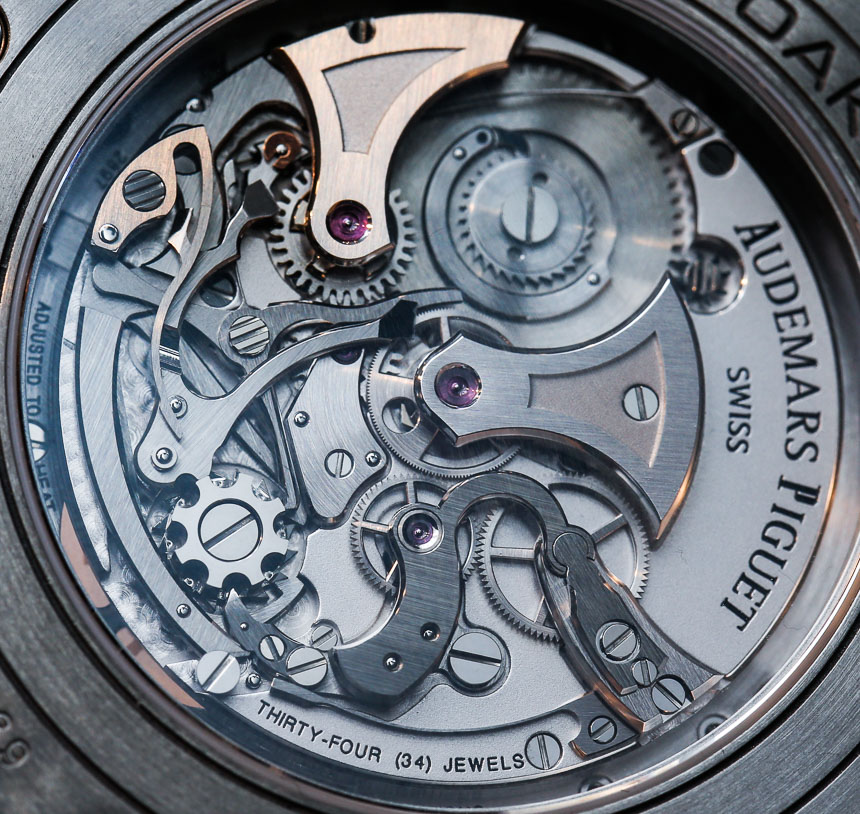
A series of improvements have been incorporated in this model including a better coupling lever and the optimization of the shapes and positions of the springs and levers, so only the slightest pressure is needed to activate the chronograph. As anybody who has had an Audemars Piguet chronograph in their hands can attest, the activation of the chronograph is silky-smooth.
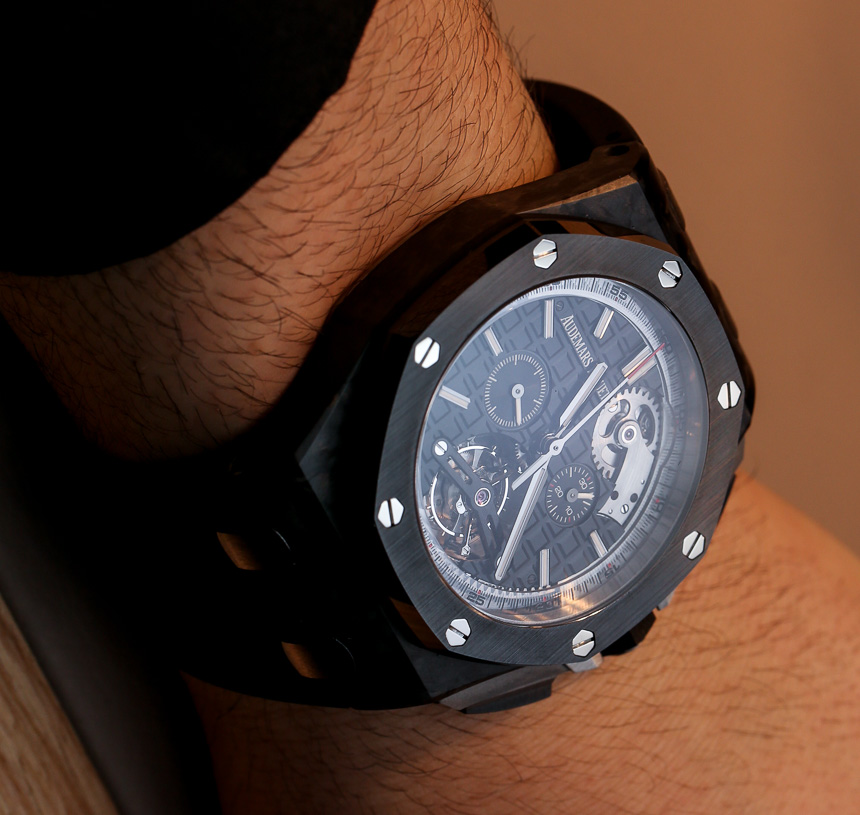
Thanks to the yoke clutch, there is a dual regulation of the gear trains, a feature exclusive to Audemars Piguet. This, together with a synchronization-regulating operation undertaken by the watchmakers, ensures that the chronograph hand does not jump when activated. In addition, the 30-minute counter is equipped with a device that enables a semi-instant jump of the chronograph minute hand within an interval of approximately half a second. This way, the time reading is more precise since the transition from one minute to the next is faster and gives a clear indication of the number of minutes elapsed.
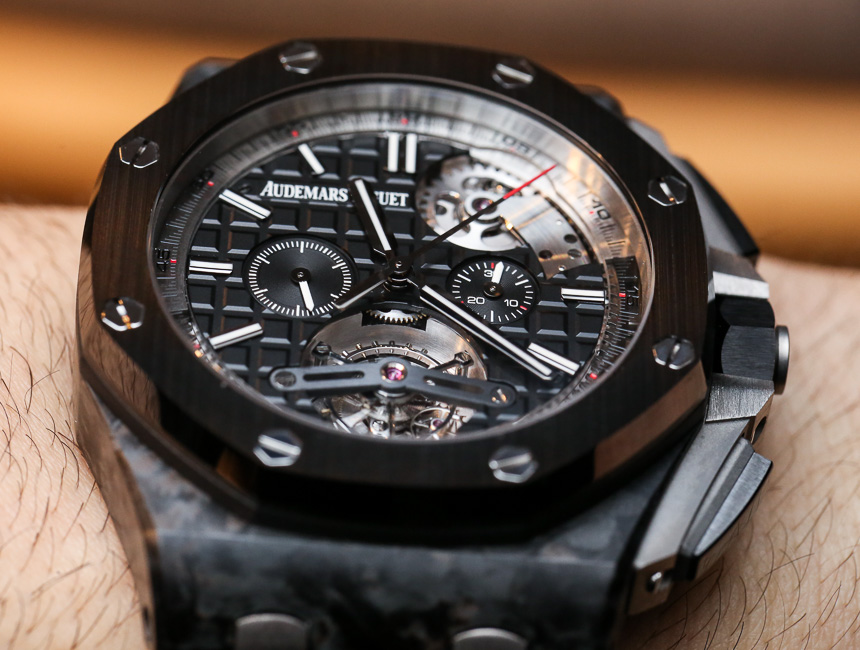
Completing the high-tech appeal of the watch, the strap is made from black rubber and closes around the wrist with a titanium pin buckle. Royal Oak Offshore watches, as this Audemars Piguet Royal Oak Offshore Selfwinding Tourbillon Chronograph so eloquently attests, are designed to stand out from the crowd and are not for the faint of heart. A limited edition of just 50 pieces, the watch will become a talking piece given its rare sightings and is priced at $287,200. audemarspiguet.com

